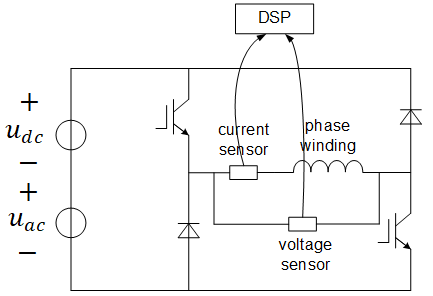Dynamic measurement of magnetic characteristics of switched reluctance motor
DOI:
https://doi.org/10.20998/2074-272X.2023.2.01Keywords:
magnetic characteristics, saturation, switched reluctance motorAbstract
Introduction. Switched reluctance motor (SRM) is a type of electric motor featuring nonlinear magnetic characteristics. The flux linkage or inductance profile of SRM is usually required for the purpose of high control performance, and can be normally obtained through conventional static test by using DC or AC method when the rotor is locked. Problem. However, it is not practical to use the conventional method of measurement when the specific apparatus for locking the rotor is unavailable. Besides, due to the magnetic nonlinearity of SRM, the saturation effect makes it difficult to obtain the saturated magnetic characteristics, and the conventional static AC test fails to address this problem. Novelty. In this paper, a dynamic measurement method of the magnetization curves of SRM is proposed which allows the measurement take place while the motor is running with load. Methodology. Based on the conventional static AC test, the proposed measurement handles the saturation problem successfully by introducing a DC offset in the high frequency AC voltage. Phase inductance with different rotor positions and currents can be obtained by analyzing simple equivalent circuit. Practical value. Simulation is conducted in MATLAB/Simulink environment and the results have verified that the proposed dynamic measurement can effectively obtain the magnetic characteristics of SRM.
References
Pan J.F., Cheung N.C., Gan W.C., Zhao S.W. A Novel Planar Switched Reluctance Motor for Industrial Applications. IEEE Transactions on Magnetics, 2006, vol. 42, no. 10, pp. 2836-2839. doi: https://doi.org/10.1109/TMAG.2006.879143.
Zhang T., Chen J., Zhu W. Suspension Performance Analysis on the Novel Hybrid Stator Type Bearingless Switched Reluctance Motor. IEEE Transactions on Magnetics, 2021, vol. 57, no. 6, pp. 1-4. doi: https://doi.org/10.1109/TMAG.2021.3064078.
Niguchi N., Hirata K.N., Takahara K., Suzuki H. Proposal of a New Coil Arrangement for a Four-Phase Switched Reluctance Motor. IEEE Transactions on Magnetics, 2021, vol. 57, no. 2, pp. 1-6. doi: https://doi.org/10.1109/TMAG.2020.3019082.
Chen H.-C., Wang W.-A., Huang B.-W. Integrated Driving/Charging/Discharging Battery-Powered Four-Phase Switched Reluctance Motor Drive With Two Current Sensors. IEEE Transactions on Power Electronics, 2019, vol. 34, no. 6, pp. 5019-5022. doi: https://doi.org/10.1109/TPEL.2018.2880259.
Chen H., Yu F., Yan W., Orabi M. Calculation and Analysis of Eddy-Current Loss in Switched Reluctance Motor. IEEE Transactions on Applied Superconductivity, 2021, vol. 31, no. 8, pp. 1-4. doi: https://doi.org/10.1109/TASC.2021.3091068.
Ahmad S.S., Narayanan G. Evaluation of DC-Link Capacitor RMS Current in Switched Reluctance Motor Drive. IEEE Transactions on Industry Applications, 2021, vol. 57, no. 2, pp. 1459-1471. doi: https://doi.org/10.1109/TIA.2020.3048637.
Zhu J., Cheng K.W.E., Xue X. Design and Analysis of a New Enhanced Torque Hybrid Switched Reluctance Motor. IEEE Transactions on Energy Conversion, 2018, vol. 33, no. 4, pp. 1965-1977. doi: https://doi.org/10.1109/TEC.2018.2876306.
Bibik O.V., Mazurenko L.I., Shykhnenko M.O. Formation of characteristics of operating modes of switched reluctance motors with periodic load. Electrical Engineering & Electromechanics, 2019, no. 4, pp. 12-16. doi: https://doi.org/10.20998/2074-272X.2019.4.02.
Kiyota K., Chiba A. Design of Switched Reluctance Motor Competitive to 60-kW IPMSM in Third-Generation Hybrid Electric Vehicle. IEEE Transactions on Industry Applications, 2012, vol. 48, no. 6, pp. 2303-2309. doi: https://doi.org/10.1109/TIA.2012.2227091.
Yang Z., Shang F., Brown I.P., Krishnamurthy M. Comparative Study of Interior Permanent Magnet, Induction, and Switched Reluctance Motor Drives for EV and HEV Applications. IEEE Transactions on Transportation Electrification, 2015, vol. 1, no. 3, pp. 245-254. doi: https://doi.org/10.1109/TTE.2015.2470092.
Lin Z., Reay D.S., Williams B.W., He X. Online Modeling for Switched Reluctance Motors Using B-Spline Neural Networks. IEEE Transactions on Industrial Electronics, 2007, vol. 54, no. 6, pp. 3317-3322. doi: https://doi.org/10.1109/TIE.2007.904009.
Gao H., Salmasi F.R., Ehsani M. Inductance Model-Based Sensorless Control of the Switched Reluctance Motor Drive at Low Speed. IEEE Transactions on Power Electronics, 2004, vol. 19, no. 6, pp. 1568-1573. doi: https://doi.org/10.1109/TPEL.2004.836632.
Yao S., Zhang W. A Simple Strategy for Parameters Identification of SRM Direct Instantaneous Torque Control. IEEE Transactions on Power Electronics, 2018, vol. 33, no. 4, pp. 3622-3630. doi: https://doi.org/10.1109/TPEL.2017.2710137.
Radimov N., Ben-Hail N., Rabinovici R. Inductance measurements in switched reluctance machines. IEEE Transactions on Magnetics, 2005, vol. 41, no. 4, pp. 1296-1299. doi: https://doi.org/10.1109/TMAG.2005.844835.
Peng Zhang, Cassani P.A., Williamson S.S. An Accurate Inductance Profile Measurement Technique for Switched Reluctance Machines. IEEE Transactions on Industrial Electronics, 2010, vol. 57, no. 9, pp. 2972-2979. doi: https://doi.org/10.1109/TIE.2010.2048831.
Ustun O. Measurement and Real-Time Modeling of Inductance and Flux Linkage in Switched Reluctance Motors. IEEE Transactions on Magnetics, 2009, vol. 45, no. 12, pp. 5376-5382. doi: https://doi.org/10.1109/TMAG.2009.2026897.

Downloads
Published
How to Cite
Issue
Section
License
Copyright (c) 2022 J. Fan, Y. Lee

This work is licensed under a Creative Commons Attribution-NonCommercial 4.0 International License.
Authors who publish with this journal agree to the following terms:
1. Authors retain copyright and grant the journal right of first publication with the work simultaneously licensed under a Creative Commons Attribution License that allows others to share the work with an acknowledgement of the work's authorship and initial publication in this journal.
2. Authors are able to enter into separate, additional contractual arrangements for the non-exclusive distribution of the journal's published version of the work (e.g., post it to an institutional repository or publish it in a book), with an acknowledgement of its initial publication in this journal.
3. Authors are permitted and encouraged to post their work online (e.g., in institutional repositories or on their website) prior to and during the submission process, as it can lead to productive exchanges, as well as earlier and greater citation of published work.




